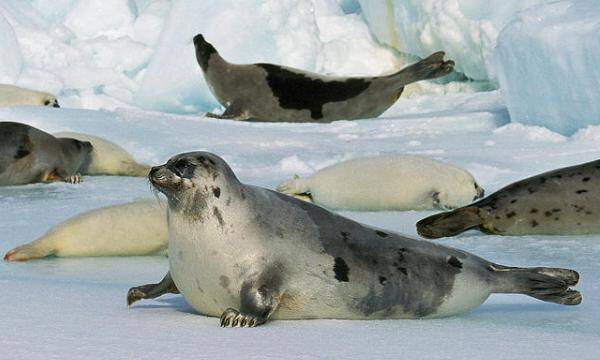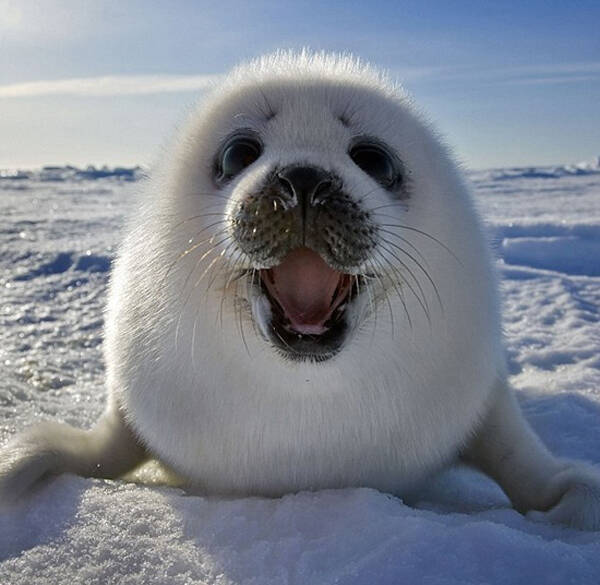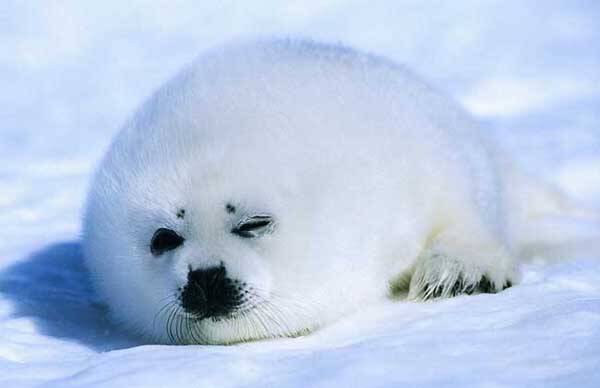Pagophilus groenlandicus
IUCN
LCBasic Information
Scientific classification
- name:Pagophilus groenlandicus
- Scientific Name:Pagophilus groenlandicus,Harp Seal、Greenland Seal,Greenland seal, ice seal, Lyra seal, saddle seal
- Outline:Carnivora
- Family:Phocaeophagidae H.seal
Vital signs
- length:168-190cm
- Weight:120-135kg
- lifetime:20-35years
Feature
Distinct black bands forming numerous saddle marks on the back, generally in the shape of a harp
Distribution and Habitat
Widely distributed in the North Atlantic and Arctic Oceans.
Origin (sea): Canada, Greenland, Iceland, Norway, Russia, Svalbard and Jan Mayen Island.
Roaming (sea): Denmark, Faroe Islands, Finland, France, Germany, Spain, the United Kingdom, the United States.
Mainly active in coastal waters near floating ice, and swim to the open sea during migration. They go to the Arctic floating ice area for breeding, molting and recuperation.
Appearance
Adults have striking black markings on the upper body, shaped like a harp or horseshoe, which is why they are called "harp seals".
Adults: Silver-gray fur (females have black spots), with black markings on both sides of the body. The head is black, and the female's face is white with spots. The face is wide and the eyes are close together. The whiskers are well developed. The claws of the front and rear flippers are black, and there are often black spots at the junction of the rear flippers and the trunk.
Newborns are covered with white fetal hair, and the fur color gradually changes to silver-gray with irregular black spots after more than half a month.
Tooth formula: I 3/2, C 1/1, PC 5/5. Note (I: incisor, C: canine, PC: post-canine)
Size measurement: body length ♂171~190 cm, ♀168~183 cm; average weight ♂135 kg, ♀120 kg. (Note: ♂male; ♀female)
Details
Harp seal (scientific name: Pagophilus groenlandicus) is also known as Harp Seal and Greenland Seal. It has no subspecies.

Harp seals can travel 5,000 kilometers a year. Their migration pattern depends on where they breed and shed. They breed in the southernmost part of their distribution area in winter and shed their fur nearby in spring. After shedding their fur, they return to the northernmost part of their distribution area to spend the summer. They return to their breeding grounds in September. Harp seals gather in groups only during the breeding season and shedding period, and prefer to be alone at other times. The seal groups they form do not have a social or hierarchical system.
Harp seals spend most of their time at sea and spend less time on land. They usually try to land at night. They stay the longest during the breeding and shedding periods. They spend more energy digging holes (hole diameter 60~90 cm) on the ice floes to enter the water and breathe. They are good at swimming and can move quickly on the ice. In addition to the use of front and rear flippers to propel the body in the water, they can also regulate body temperature and pursue the opposite sex. They can go to deep water to find food, with an average diving depth of 150~200 meters and a diving time of 4~13 minutes. The main food is fish, and the diet includes 67 kinds of fish and 70 kinds of marine invertebrates, such as capelin and Arctic cod. The young eat small invertebrates.
The hearing and vision of harp seals are very sensitive. The well-developed whiskers can sense low-frequency vibrations to detect prey and predators. The sense of smell is not as sharp as other senses, but it can distinguish between young and predators. Predators include polar bears, killer whales, Greenland sharks and walruses.

In winter, up to 2,000 harp seals can gather per square kilometer on the ice of their breeding grounds. The mating system is controversial and is usually described as monogamous or polygamous. Both females and males mature at around 5.5 years of age. The average breeding age for females is 10 years and for males is 8 years.
The gestation period of females is about 11.5 months. They breed on the ice floes from February to April every year. Each litter has one pup, which is about 1 meter long and weighs 11 to 12 kilograms at birth. The pup has white fur, with only the nose and snout being black. Harp seals do not have a fixed mate. The pups never know their fathers, and the mother seals are responsible for raising their offspring. In about 10 to 12 days, the mother seal spends 85% of her time foraging underwater to replenish her milk consumption, and spends the rest of her time nursing her pups. The seals rely entirely on breast milk for the first week after birth, feeding four or five times a day. The amount of milk produced by female seals is ten times more than that of cows. The weight of a pup can increase three times after ten days. A thick layer of fat will be generated to resist the cold.
After the lactation period, the female seal returns to the sea, and the 33 kg pup is abandoned alone on the ice, where the pup completes the process of molting from white to silver-gray. After four weeks, it is completely independent and can go into the water to find food. From being abandoned to hunting independently, the little guys lose 50% of their body fat and the mortality rate reaches 20~30%. The life span of wild harp seals is 20~35 years.

Harp seals are the most abundant pinnipeds in the Northern Hemisphere. There are nearly 9 million of them worldwide, with about 1.2 million new pups born each year (ICES 2013, Hammill et al. 2014). About 7.5 million in the North Atlantic (Hammille et al. 2014), of which 627,000 are in Greenland (ICES 2013, Øigård et al. 2014); an estimated 1.4 million in the North Sea (ICES 2013). The scale of the Greenland (regional) harp seal hunt increased from 1,500 per year in the 1970s to about 100,000 in 2000, and has maintained an average of 85,000 per year since then (DFO 2012).
Listed in the IUCN Red List: Least Concern (LC), assessed in 2008.
Listed in China's "National Key Protected Wildlife List": National Class II Protected Animals (effective December 10, 1988, all species of Pinnipedia*).
Protect wildlife and eliminate game.
Maintaining ecological balance is everyone's responsibility!








